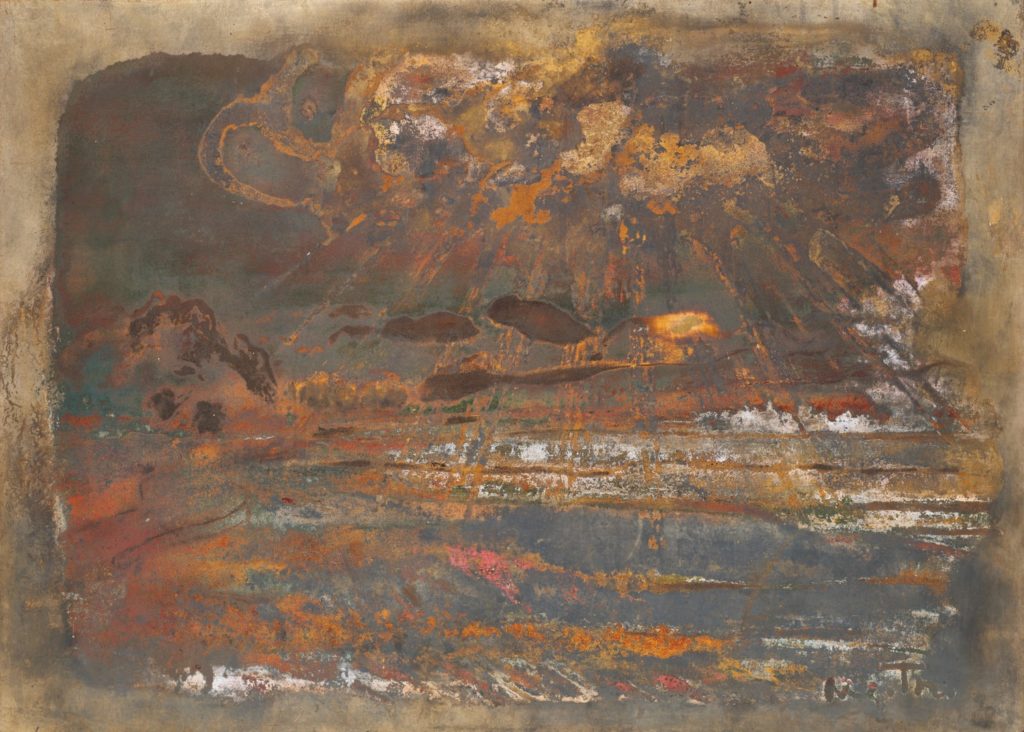Nguyen Gia Tri, 1970, « Ombres et lumières sur la Moyenne Région » (Shadows and Light of the Middle Region) or “blandness”, supreme clarity of the soul
“Shadows and light on the Middle Region” is a breathtaking lacquer (44 X 61 cm) by Nguyen Gia Tri.
Executed in 1970, it is the crucial witness to a precise historical context, the brilliant expression of the artist’s talent at his peak, the subtle manifestation of an indescribable feeling.
It is a milestone in the painter’s oeuvre.

An essential witness to a specific historical context
In 1970, settled in Saigon, Nguyen Gia Tri had left his native North – he was born there, in Hadong, in 1908 – since 1953. From an early age, he was an active militant in Việt Nam Quốc Dân Đảng, the revolutionary nationalist party founded on December 25, 1927, and a full participant in Tự Lực văn đoàn, the social and cultural emancipation movement that began in 1932. As well as being an artist, he was also an attentive analyst of the political situation of his time, and in 1970 he was tormented by the gravity of the moment.
The Têt offensive two years earlier had shown the fragility of the South’s situation and the slow erosion of its military capabilities. Having already been exiled to Hong Kong and then forced to leave the North, he realized that he would probably never see the Middle Region of his native Tonkin again. At 62, with a lifetime of artistic and political struggle behind him, he knew that a man could be deprived of everything but his nostalgia.
Nostalgia, “the lack of the past as it was” (André Comte-Sponville) structures our lacquer. There’s no regret here, because the memory is always present, no gratitude either, because the lack is there. And no hope…
The best lacquerer of his generation, to sublimate his nostalgia, offers us one of his most accomplished compositions.
A brilliant expression of the talent of a mature artist
Our work goes beyond the sometimes over-decorative majesty of the artist’s earlier classical works, and goes beyond his later compositions, which can be a little monotonous because a little too mechanical.
Two choices in particular characterize the work: pale tones and semi-abstract description.
Deliberately pale tones.
Three well-documented works, sold by Christie’s Hong Kong, “La Perfection ou Femmes et Jardins du Vietnam“, painted from 1956 to 1959, “Les Élégantes” painted in 1968, and “Nostalgie du Haut Tonkin“, also executed in 1968, strong in color, refute the legend of a lack of “color” in the South following the 1954 partition. Phu To’s lacquer, now virtually unobtainable, would have obliged Nguyen Gia Tri – in some compositions – to use these duller tones than usual.
Not so. It’s true that very early on, particularly within the Gia Dinh School (founded in 1913), the differences between Northern lacquer from Phu To and Phnom Penh lacquer from neighboring Cambodia were identified. For example, the latter dries faster and is easier to apply, with deeper, richer, darker pigments. It’s also true that, until now, the border blockade between Vietnam and Cambodia has prevented imports and led to a spike in lacquer prices. In the 60s, these differences and high prices even led to the development of a lacquer-based paint called “artificial paint”, offering all the colors of oil paint, easy to apply and economical, with fast, long-lasting pigments. But none of this concerns our painter.
A semi-abstract description.
In his painting, the artist expresses himself in fine brushstrokes. He forces us to open our eyes and grasp the perspective of his depiction.
On the periphery, like an atmosphere, the light beige of the sky and the evocation of distant peaks that call to mind the High Region.
In the center, a massive rectangle dominated by tones of gray, rust and ochre, where blue-green, brown, gray, pink, green and white mingle and intermingle. In brown, more figurative, are the foothills on which a “sugar loaf” is outlined, and other, closer peaks in darker red. A house with a golden roof.
Below, rice paddies in a line.
In the middle and above, clouds pierced by the sun’s rays. And an atmosphere of impending rain, so typical of the region.
Deliberately soft tones and a dilution-diffusion of representation like a diffraction through the prism of memory. Memory…
The subtle manifestation of an unspeakable feeling
“When the various flavors, ceasing to oppose each other, remain in plenitude: the merit of blandness is to give us access to this undifferentiated depth of things” writes philosopher François Jullien in his Éloge de la Fadeur ( Eloge of Blandness) (Paris 1991 p19). Translated into Vietnamese (Nhà Xuât Ban, Dà Nang, 2003) and English (Zone Books, New-York, 2004)). Nguyen Gia Tri offers us this “undifferentiated depth of things” in the tradition of Ni Zan (1301-1374), among others.
Embodying Shitao’s (1642-1707) definition of the ideal attitude of the landscape painter: “On the limited surface of a painting, he orders Heaven and Earth, mountains, rivers and the infinity of creatures, and all with a detached heart and as if in nothingness.” A particular state of consciousness is required here. In a subtle dialectic, everything that might refer to freedom, detachment, sobriety and pared-downness must come together. Ni Zan used that “pale-insipid” ink typical of the secret flavors of literary creation. Nguyen Gia Tri uses his pale colors to build an animated void where everything is offered while everything seems hidden.
It’s the magic of the language of painting that allows us to formulate what we cannot enunciate.
Nguyen Gia Tri, and this is the sumptuousness of his work, offers us his memory of the North as the essential page not reread but torn from the book of his life.
Like an inner exile.
Nguyen Gia Tri’s deliberate blandness expresses the most extreme flavor contained within, that of his lost and transcended land. A land that will never again be stolen from him.
Yes, blandness, that supreme clarity of the soul.
Jean-François Hubert